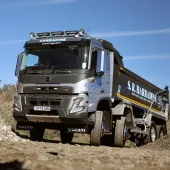Ladies wanting to take up truck driving on the rise

Women increasingly interested in driving 44-tonne HGVs, according to FTA Twitter poll
NEARLY 80% of women are keen to get behind the wheel of a lorry, and there is also a rise in younger women wanting to take up driving – according to Freight Transport Association (FTA) figures revealed this week.
A Twitter poll carried out by the FTA, asked ladies if they were willing to drive a 44-tonne truck as less than 1% of truckers are currently female. Some 79% of respondents voted ‘yes.’ As a result, the FTA now says it is important to explore why more women are not coming into the industry.
Around 2,200 of the 315,000 registered truck drivers in the UK are female, but recent statistics show that the gender balance, and younger women wanting to enter the profession is improving with 15% aged between 21 and 25.
Sally Gilson (pictured), skills policy development manager with the FTA, said: ‘These figures are encouraging as it is essential that more women are recruited – currently only 1% of HGV drivers in the UK are female.
‘We believe that one of the biggest barriers for would-be truck drivers is the cost of gaining a licence and training – around £3,000. The FTA has been calling on government to provide a suitable loan system.’
She continued: ‘The current Personal Career Development Loan option is not appropriate and a simple change to allow Level 2 qualifications to be included within the 19+ loan would provide the quickest and best solution.’
Solving the current shortfall of more than 45,000 HGV drivers is a major campaign for the Association, an issue recently recognized in a Transport Select Committee report which quoted FTA evidence reflecting difficulties logistics operators face in recruiting drivers.
The FTA Logistics Report 2016 shows that more than 64% of truck drivers are 45 or older – the average age has steadily increased over the past 15 years – and problems with filling vacancies are high on FTA members’ list of priorities.
This has been compounded in recent years by the consequence of economic growth and the huge rise in e-commerce. Lack of funding for vocational training for drivers means fewer are joining the industry and there is a real risk that the shortage of HGV drivers could severely impact the economy.









